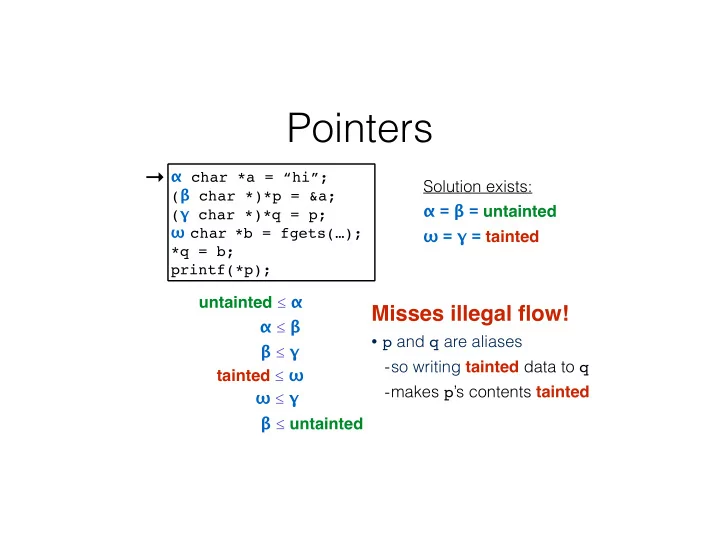

Pointers → α char *a = “hi”; ! Solution exists: ( β char *)*p = &a; ! α = β = untainted ! ( γ char *)*q = p; ! ω char *b = fgets(…); ! ω = γ = tainted *q = b; " printf(*p); untainted ≤ α Misses illegal flow! ! α ≤ β • p and q are aliases β ≤ γ -so writing tainted data to q tainted ≤ ω -makes p ’s contents tainted ω ≤ γ β ≤ untainted
Pointers α char *a = “hi”; ! Solution exists: ( β char *)*p = &a; ! α = β = untainted ! ( γ char *)*q = p; ! ω char *b = fgets(…); ! ω = γ = tainted *q = b; " printf(*p); untainted ≤ α α ≤ β β ≤ γ γ ≤ β tainted ≤ ω ω ≤ γ β ≤ untainted
Flow and pointers • An assignment via a pointer “flows both ways” • Ensures that aliasing constraints are sound ! • But can lead to false alarms • Reducing alarms • If pointers are never assigned to ( const ) then backward flow is not needed (sound) • Drop backward flow edge anyway Trades false alarms for missed errors (unsoundness) -
Implicit flows void copy(tainted char *src, ! untainted char *dst, ! int len) { ! untainted int i; ! for (i = 0; i<len; i++) { ! dst[i] src[i] dst[i] = src[i]; //illegal ! untainted char tainted char } ! } Illegal flow : tainted ≤ untainted
Implicit flows void copy(tainted char *src, ! untainted char *dst, ! int len) { ! untainted int i, j; ! for (i = 0; i<len; i++) { ! for (j = 0; j<sizeof(char)*256; j++) { " if (src[i] == (char)j) " dst[i] = (char)j; //legal? " untainted char untainted char } ! } ! } Missed flow
Information flow analysis • The prior flow is an implicit flow , since information in one value implicitly influences another • One way to discover these is to maintain a scoped program counter ( pc ) label ! • Represents the maximum taint affecting the current pc • Assignments generate constraints involving the pc • x = y produces two constraints: label ( y ) ≤ label ( x ) (as usual) pc ≤ label ( x ) • Generalized analysis tracks information flow
Info flow example tainted int src; ! α int dst; ! pc 1 = untainted pc 1 = untainted if (src == 0) ! untainted ≤ α dst = 0; ! pc 2 = tainted pc 2 = tainted α ≤ pc 2 else ! pc 3 = tainted pc 3 = tainted untainted ≤ α dst = 1; ! α ≤ pc 3 ! untainted ≤ α pc 4 = untainted pc 4 = untainted dst += 0; α ≤ pc 4 Solution requires α = tainted Discovers implicit flow
Why not information flow? • Tracking implicit flows with a pc label can lead to false alarms tainted int src; ! • E.g., ignores values α int dst; ! if (src > 0) dst = 0; ! ! else dst = 0; • Extra constraints also hurt performance ! • Our copying example is pathological • We typically don’t write programs like this • Implicit flows will have little overall influence • So : tainting analyses tend to ignore implicit flows
Other challenges • Taint through operations ! • tainted a; untainted b; c=a+b — is c tainted? (yes, probably) • Function pointers ! • What function can this call go to? • Can flow analysis to compute possible targets • Struct fields ! • Track the taintedness of the whole struct, or each field? • Taintedness for each struct instance, or shared among all of them (or something in between)? Note: objects ≈ structs + function pointers - • Arrays ! • Keep track of taintedness of each array element, or one element representing the whole array?
Refining taint analysis • Can label additional sources and sinks • Array bounds accesses: must have untainted index • Can expand taint analysis to handle sanitizers ! • Functions to convert tainted data to untainted data • Other application: Leaking confidential data • Don’t want secret sources to go to public sinks ! Implicit flows more relevant in this setting ! - • Dual of tainting
Other kinds of analysis • Pointer Analysis (“points-to” analysis) • Determine whether pointers point to the same locations • Shares many elements of flow analysis. Really advanced in the last 10 years. • Data Flow Analysis ! • Invented in the early 1970’s. Flow sensitive, tracks “data flow facts” about variables in the program • Abstract interpretation ! • Invented in the late 1970’s as a theoretical foundation for data flow analysis, and static analysis generally. • Associated with certain analysis algorithms
Static analysis in practice Commercial products ! Fortify ! ! ! ! Open source tools clang ! FindBugs analyzer ! & ! KLEE Caveat: appearance in the above list is not an implicit endorsement, and these are only a sample of available offerings
Learning more • Secure Programming with Static Analysis , by Brian Chess, goes into more depth about how static analysis tools work, and can aid secure software development • Principles of Program Analysis , by Nielson, Nielson, and Hankin, is a formal, mathematical presentation of different analysis methods • A bit dense for the casual reader, but good for introducing the academic field
Recommend
More recommend